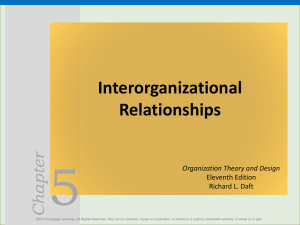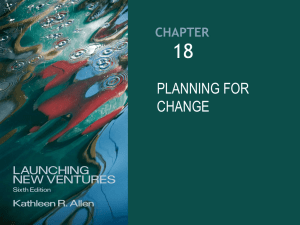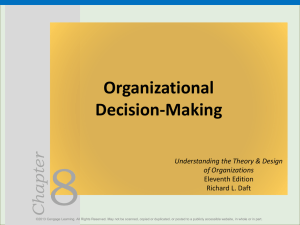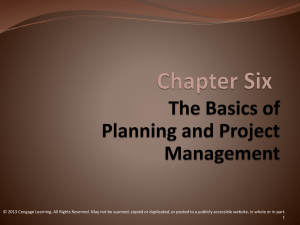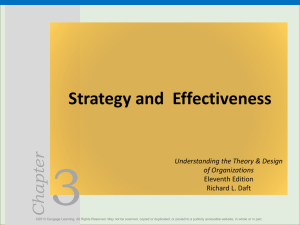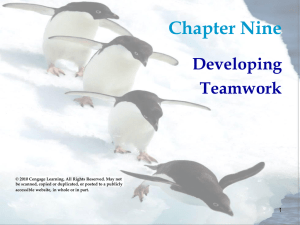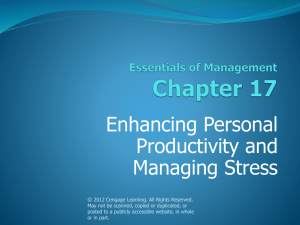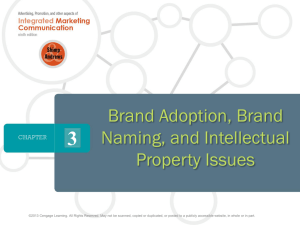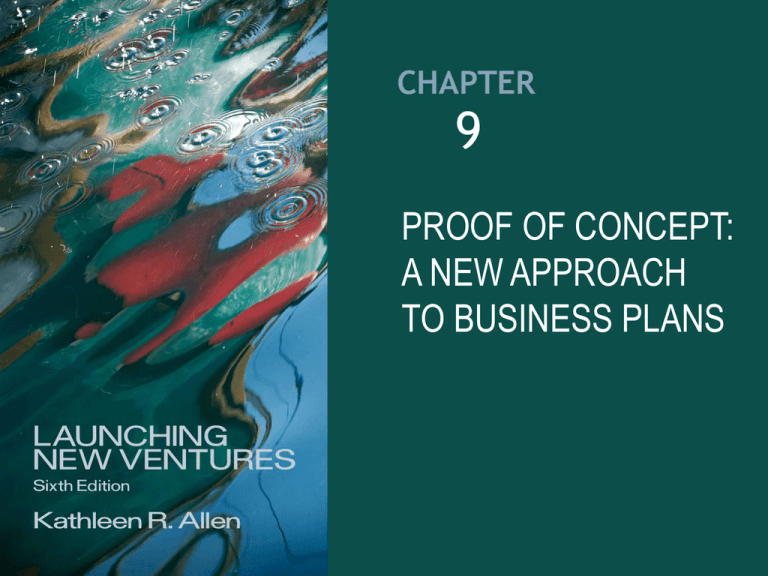
9
PROOF OF CONCEPT:
A NEW APPROACH
TO BUSINESS PLANS
©2012 Cengage Learning. All Rights Reserved. May not be scanned, copied or duplicated, or posted to a publicly accessible website, in whole or in part.
Learning Objectives
Describe how to move from a feasible concept to
a proof of concept.
Identify stakeholder interests.
Explain the components of a compelling
executive summary.
Discuss how to organize a business plan
effectively.
Describe how to successfully pitch a new
business.
©2012 Cengage Learning. All Rights Reserved. May not be scanned, copied or duplicated, or posted to a publicly accessible website, in whole or in part.
From Feasibility to Proof of
Concept
Proof of concept (POC):
• Evidence that a technology, product, business
model or idea is feasible
• Two types of POC:
• Technology or product POC
• Business model POC
©2012 Cengage Learning. All Rights Reserved. May not be scanned, copied or duplicated, or posted to a publicly accessible website, in whole or in part.
Figure 9.1
Spectrum of POC Approaches
©2012 Cengage Learning. All Rights Reserved. May not be scanned, copied or duplicated, or posted to a publicly accessible website, in whole or in part.
The Micro Strategy Approach
to Proof of Concept
Entrepreneur’s Micro Strategy for Proof of
Concept consists of three primary
elements:
1. Outcomes: near-term goals the entrepreneur
is attempting to achieve
2. Assets: human, social, physical, and financial
needed to achieve the desired outcomes
3. Actions: tasks entrepreneur must undertake
to achieve the necessary outcomes
©2012 Cengage Learning. All Rights Reserved. May not be scanned, copied or duplicated, or posted to a publicly accessible website, in whole or in part.
Micro Strategy Decision
Making
Today’s environment necessitates a greater
use of intuitive decision making.
Avoid potential failure points by
conducting a premortem.
Common failure points:
• Pattern recognition bias (“We always do it that
way”)
• Overly optimistic forecast of markets
©2012 Cengage Learning. All Rights Reserved. May not be scanned, copied or duplicated, or posted to a publicly accessible website, in whole or in part.
Proof of Concept
Proof of concept with a prototype
• Entrepreneur develops clear understanding of
customer needs.
• Changes can be made early in the process when they
are less costly.
• The prototype reduces the risk of failure.
Proof of concept with a website
• Avoid the single page marked “under construction.”
• Avoid posting proprietary information that is not
patented or trademarked.
©2012 Cengage Learning. All Rights Reserved. May not be scanned, copied or duplicated, or posted to a publicly accessible website, in whole or in part.
Proof of Concept (cont’d)
Proof of concept with purchase orders and
customer sales
• Customers that pay up front save company on
inventory costs and fund manufacturing costs.
©2012 Cengage Learning. All Rights Reserved. May not be scanned, copied or duplicated, or posted to a publicly accessible website, in whole or in part.
Investors Interests
Rate of growth
Return on investment
Degree of risk
Degree of protection
©2012 Cengage Learning. All Rights Reserved. May not be scanned, copied or duplicated, or posted to a publicly accessible website, in whole or in part.
Bankers’ & Lenders’ Interests
Company margins and cash flow projections
The amount of money needed
The kind of positive impact the loan will have on the
business
The kinds of assets the business has for collateral
How the business will repay the loan
How the bank will be protected if the business does not
meet its projections
The entrepreneur’s stake in the business
©2012 Cengage Learning. All Rights Reserved. May not be scanned, copied or duplicated, or posted to a publicly accessible website, in whole or in part.
Strategic Partners’ Interests
Licenses for manufacturing and assembly
Supply of raw materials in exchange for
equity interest
Formal or informal partnership agreements
©2012 Cengage Learning. All Rights Reserved. May not be scanned, copied or duplicated, or posted to a publicly accessible website, in whole or in part.
Creating a Compelling Story
In an executive summary:
• Convey the compelling story quickly and
memorably.
• Highlight the critical elements of the business
that provide a competitive advantage.
• Present a coherent path to profitability and
success that make sense.
• Demonstrate that the team can successfully
execute the plan.
©2012 Cengage Learning. All Rights Reserved. May not be scanned, copied or duplicated, or posted to a publicly accessible website, in whole or in part.
Creating a Compelling Story
(cont’d)
Should answer these questions:
1.
2.
3.
4.
5.
6.
7.
8.
What is the compelling story?
What pain is being addressed?
How is the venture solving the problem?
What is this venture’s competitive advantage?
Can this venture make money?
Can the founding team serve that need?
Why is now the right time to launch this venture?
What is the team seeking from investors?
©2012 Cengage Learning. All Rights Reserved. May not be scanned, copied or duplicated, or posted to a publicly accessible website, in whole or in part.
The Full Business Plan:
Strategy and Structure
Tasks to guide the preparation of the plan:
• Identify who is responsible for what.
• Develop a timeline based on tasks identified.
• Hold the team to the timeline and work
diligently to get the plan done.
©2012 Cengage Learning. All Rights Reserved. May not be scanned, copied or duplicated, or posted to a publicly accessible website, in whole or in part.
Components of Business Plan
Executive Summary
The Business
Founding/Management
team
Industry/market analysis
Product/service
development
Operations plan
Organization plan
Marketing plan
Financial plan
Growth plan
Contingency plan & harvest
strategy
Timeline to launch
Appendices
Endnotes
©2012 Cengage Learning. All Rights Reserved. May not be scanned, copied or duplicated, or posted to a publicly accessible website, in whole or in part.
Financial Plan
Complete set of financial statements:
• Statement of cash flows
• Income statement
• Balance sheet
Key ratios to gauge progress
•
•
•
•
Current ratio
Profit margin
Return on Investment (ROI)
Inventory turnover
©2012 Cengage Learning. All Rights Reserved. May not be scanned, copied or duplicated, or posted to a publicly accessible website, in whole or in part.
Mistakes in Developing
the Business Plan
Projected rapid growth that requires capabilities
beyond those of the founding team
Envisioning a three-ring circus with only one
ringleader
Reporting performance that exceeds industry
averages
Using price as a market strategy for a
product/service
Not investing capital in their own businesses
©2012 Cengage Learning. All Rights Reserved. May not be scanned, copied or duplicated, or posted to a publicly accessible website, in whole or in part.
Successfully Pitching the
Business
Keep the presentation to less than 30 minutes
Tell a compelling story first
Do not use a podium to speak
Move about without distracting the audience
Maintain eye contact with everyone
Make the visual aids simple
Use live demonstrations
CEO should do the presentation
Practice in advance
©2012 Cengage Learning. All Rights Reserved. May not be scanned, copied or duplicated, or posted to a publicly accessible website, in whole or in part.
Answering Questions
Investors like to ask what they already
know the answer to.
Trick questions are likely.
Don’t be afraid to not know the answer.
Founding team can join the CEO for
questions.
©2012 Cengage Learning. All Rights Reserved. May not be scanned, copied or duplicated, or posted to a publicly accessible website, in whole or in part.
New Venture Action Plan
Develop a micro strategy approach to
achieving proof of concept.
Identify the stakeholders in the business
and their interests.
Create a compelling executive summary
and pitch.
Plan the development of a full business
plan.
©2012 Cengage Learning. All Rights Reserved. May not be scanned, copied or duplicated, or posted to a publicly accessible website, in whole or in part.


